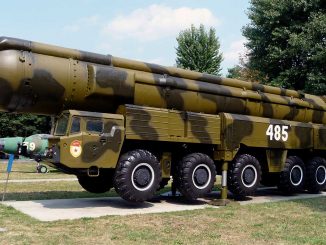One of the most difficult challenges for modern technology is to cope with unpredictable, and non-linear, behavior in modern warfare and with a military culture that will remain, conservative, traditional, and consequently, highly resistant to technology change.
Remarks by The Honorable Jacques S. Gansler, Under Secretary of Defense (Acquisition and Technology), NATO Workshop, Norfolk, Virginia, November 12, 1998. Source
After a series of very dramatic and terrifying world events this past year, the collective public attention of the United States and Europe has finally focused on the vast, complex geopolitical, economic, and technological upheaval that is taking place in the world. We no longer need to be reminded that we face a very real — and present — set of new threats from a variety of asymmetric forces capable of being directed against us from all parts of the world. Recent terrorist bombings in Kenya and Tanzania, the conflicts in Bosnia and Kosovo, the North Korean and Iranian ballistic missile launches, the nuclear explosions in India and Pakistan, the growing proliferation of low-cost cruise missiles, and the sophisticated cyber attacks on the U.S. Department of Defense computer systems have brought home to all of us the very different nature of the present and growing threats to our national security.
While we cannot say for certain how such new threats will evolve, they are unlikely to go away. In fact, as transnational terrorist elements and rogue nations shift to biological and chemical attacks (both at home and abroad) and launch information warfare attacks on our infrastructure (for example, against our air traffic control systems and/or our electronic financial systems), these threats are clearly likely to grow in number and intensity.
Terrorist threats that rely on early 21st century technology are, of course, only one end of the spectrum of future threats we must be prepared to face. We must also prepare for a diverse and unpredictable threat that combines more traditional forms of conflict with acts of terrorism. And, even in these more « traditional » areas, that include everything from small-scale — often urban — military operations on up to nuclear war, military conflict is being dramatically transformed by the rapidly changing nature of modern technology.
For the most part, this is nothing new. Throughout history, advances in technology have directly and indirectly transformed the course of warfare. From spear and longbow, to the invention of gunpowder and dynamite, to the use of aircraft and machine guns, and on to nuclear weapons and ballistic missiles, we have seen how revolutionary advances in weaponry have influenced the nature and extent of combat. Up to this point, however, the primary use of technology has always been to provide advantage to one side’s massed forces in its efforts to defeat the other side’s massed forces.
All this is about to change. The end of the Cold War, the breakup of the Soviet Empire, the emerging power of rogue nations, the rise of transnational terrorism, and other equally destabilizing geopolitical events, are transforming our vision of 21st century security needs and our NATO military strategy. Two fundamental changes seem clear:
- first, the NATO Alliance will see more short, intense regional conflicts (perhaps followed by extended « peacekeeping » operations). And,
- second, NATO will seek to project power without putting large numbers of its forces at risk. Massed forces will be replaced by massed firepower, precisely placed on targets. Modern, « reconnaissance/ strike » warfare, as it is called, is based on real-time, all-weather, accurate and secure surveillance, reconnaissance, intelligence, and communications systems combined with long-range, unmanned, « brilliant », highly-lethal weapons designed to achieve precision kills (even on moving targets).
Technology can also enable us to reduce dramatically our response time to unpredictable geopolitical events. The type of regional conflict that we will see more frequently in the 21st century will rarely allow NATO six months to build up forces and deploy them. There also will no longer be « free » ports or airfields. Aggression will be instantaneous, with little warning, brutal, and difficult to defend against. This is particularly true in the case of aggression by transnationals and international terrorist organizations — because they are willing to sacrifice themselves and their own civilian populations, as well as hostile civilian populations, to achieve their objectives. In this environment, traditional means of deterrence may not be highly effective.
Our reaction to this new form of aggression must be swift and decisive. The first few days, if not the first few hours, can easily determine the outcome. Our response must come within 24 hours, with sustainability in place in seven days — not in weeks or months. Such responsiveness requires a significant change in doctrine, tactics, organization, equipment, and — particularly — decision making. The NATO Alliance will need to take transformational steps to leverage this change.
The current and likely future geopolitical situation will most certainly involve increased use of multinational coalition operations. In the new geopolitical environment, each nation’s security becomes highly interdependent on the willingness and ability of coalition partners to act in concert when threatened by hostile forces. Technology — when proper coalition planning and implementation are achieved — enables us to act effectively — in fact, synergistically — to achieve the limited objectives we seek. At a minimum, this means that NATO’s systems must be fully interoperable and secure. The rapid global spread of modern information technology makes this possible; but some allied nations are not moving rapidly to take advantage of it; nor, when they do take advantage of it, are they careful to assure its security.
Unfortunately, much of the new technology is also readily available to potential enemies: commercial communications/navigation/earth surveillance satellites, biological/chemical weapons, and low-cost cruise and ballistic missiles. If they can’t develop them on their own, they can purchase them — and the skills to use them — on the world arms market.
Therefore, our coalition partners must develop and deploy effective countermeasures: information warfare defenses, vaccines and special medical agents to counter biological and chemical weapons, defenses against ballistic and cruise missiles, and the ability to destroy hard and deeply buried targets.
To stay ahead of the enemy, we must develop these new defenses as partners. For example: ballistic missile defense — essentially hitting a bullet with a bullet — poses a particularly difficult challenge; and deploying an integrated NATO theater missile defense system — one that collectively hits all the incoming missiles instead of all of us independently going for the first one coming at us — is an even more demanding technical and management problem. Unless all systems — sensors, weapons, and communications — are fully interoperable, these complex theater missile defense « systems of systems » cannot be effective. Interoperability is a major challenge and one of my top priorities as Under Secretary of Defense for Acquisition and Technology. We simply cannot fight effectively as a coalition, within NATO, unless we have fully interoperable equipment and communications – all of which must be secure and dependable. The historic objective of multinational armaments cooperation has been to achieve cost reductions. While important, this has become a secondary goal to the military necessity of coalition force interoperability.
Perhaps the most important implication of the rapid global spread of technology is the need for NATO to accelerate its technological advantage on the battlefield in order to stay ahead of our potential enemies. Since, as noted above, a terrorist or rogue nation can easily acquire much of the required advanced technology on the world arms market or from readily available commercial sources, our advantage is quickly eroded unless we keep at least two steps ahead of the enemy. This requires not only far greater technology transfer controls — in militarily critical areas — it also requires us to reduce cycle times significantly in the development and procurement of new and modified weapons systems. Current cycle times for major systems run as long as 18 years. We must begin to think in terms of very short cycles (18 months is the norm for current commercial information systems), if we are to continue to outpace our adversaries.
In order to meet the demands for such vastly reduced cycle times, we must be willing to abandon traditional methods of developing and procuring advanced weapons systems. In addition, something must be done about the cost of our defense systems. Weapons that used to cost in the thousands or hundreds of thousands of dollars now cost millions or tens of millions — some even in the billions. If we are to produce affordable systems quickly, we clearly must pursue non-traditional acquisition approaches; such as maximum use of commercial equipment, as well as significant design process changes, such as:
- treating unit cost as a military requirement,
- use of the highly-successful « open systems » approach to insertion of new technology into existing weapons systems,
- and (in the production area) use of integrated civil and military commercial assembly lines for defense-unique items. We must take maximum advantage of the potential offered by flexible manufacturing, as well as « lean » design and production techniques.
We must also realize that, for at least the next decade, new weapons systems will not be fully deployed in sufficient quantities to replace most current systems. Thus, we will be fighting, for the most part, with what currently exists. This has already resulted in a serious aging and obsolescence problem. This year, for example, the average age of our military aircraft is 20 years – although many of them were originally designed for a life span of 15 years.
The costs of operating and supporting these systems are skyrocketing — and their readiness is declining. Therefore, we must divert significant resources to improve the reliability and maintainability of this existing equipment and, at the same time, upgrade performance. Investments in modernization programs, such as digitization of current battlefield equipment, will enable us to do this. But funds for modernization dollars have been hard to come by.
A key source for such funds is from a reduction in the excessive and inefficient support infrastructure that now exists. Our logistics system, for example, is one area where we can achieve both support cost savings and promote more effective force projection, mobility, and rapid response. At the present time, more than one-third of the total U.S. Department of Defense budget is earmarked for logistics. Nearly 50 per cent of our manpower is in logistics. (In fact, military logistics support personnel outnumber active combat forces by two to one.) Here, as has been clearly demonstrated by world-class commercial logistics organizations, modern technology can come to our aid — dramatically reducing inventory, personnel and response times. Typical examples are reductions of order-to-receipt time from 40 days to four days, with far fewer people and significantly smaller inventory. Information technology and rapid transportation, combined with long-range precise weaponry designed to hit targets without deploying large quantities of combat forces or materiel, are the keys to improved logistics performance at much lower costs. However, as the U.S. increasingly operates within coalitions, it is important to note that narrowly focused unilateral logistics performance improvements will not yield the desired benefits in responsiveness and cost savings that are expected. It is therefore important that the Alliance work to adopt a corollary, common logistics system.
Since our future military requirements are likely to be based on short-duration, regional conflicts — using coalition forces operating modern-technology equipment and weapons systems that are fully interoperable, and that are developed, produced, and supported at low cost and on very short cycles — we must significantly transform our defense industrial base to support us in this effort. To accomplish this goal, the NATO Alliance must adopt a new approach to Transatlantic Armaments Cooperation. This new approach should satisfy NATO’s future defense requirements by promoting harmonization of allied government requirements — properly resource constrained — along with industry-driven, competitive teaming arrangements. Governments would agree on common requirements, then invite defense firms to form transatlantic competitive teams of their own choosing, drawing primarily from firms in each of the participating nations. Depending upon the complexity and production volume of the project, NATO governments would select the approach that maintains competition and shared national responsibilities as far through the procurement process as possible.
This new approach must draw on the best acquisition practices being applied in both the defense and commercial sectors. NATO must take advantage of new approaches, such as Advanced Concept Technology Demonstrations (ACTDs), for dramatically reducing development cycle times. NATO must also focus on maximizing the use of commercial technologies and end items, especially in critical areas such as communications and computing, where 18-month product development cycles are common. The task of harmonizing military requirements, while primarily a government function, must also be addressed by industry because industry is involved in the iterative process by which such requirements are refined and their affordability validated. The demands of coalition warfare and the associated requirement for interoperability of equipment and systems have important implications for each nation’s defense within the alliance. Since it would appear that, in the future, there will be very few areas where nations can afford a unique, independent industrial capability, cooperation represents a tremendous opportunity for creating greater efficiency, increased interoperability, and much less duplication.
Adopting this new approach will require government and industry to address difficult issues. These include future transatlantic industrial structures and corresponding safeguards for military technology. Here, the U.S. wants to encourage transatlantic (in fact, global) industrial linkages. This requires that we pay increased attention to critical military technology controls (not only in legislation and required procedures, but also in practice).
Industry (on both sides of the Atlantic) has been asking us to put out « clarifying guidance » on what added forms of industrial multinational defense mergers would be acceptable. In general, we recognize the need for future coalition warfare and the complementary clear industrial trend of globalization, along with the requirement for greater interoperability of allies’ equipment and the potential of international companies to achieve this. However, especially in the cyber age, control of militarily significant technology becomes even more critical – if we are to maintain our military superiority.
Thus, we believe that we must establish new security structures and stronger multinational controls. There will be some countries that have common legal and ethical practices and enforcement. They apply and enforce rigid technology leakage and third country sales controls. With these countries, we should be able to relax some of our traditional foreign ownership controls – while, of course, still applying the normal antitrust considerations, as well as the normal security controls for all other potential transatlantic linkages. We are in the process of formalizing some such new « clarifying guidance » with regard to global industrial alliances.
Other issues that need to be addressed include developing an efficient, effective NATO framework that addresses transatlantic industrial cooperation; harmonization of affordable military requirements; security of supply; export control procedures; security of information; efficient use of research and technology funding; controls on ethical behavior, (i.e. bribes), and treatment of technical information and intellectual property rights.
We must develop a plan to identify ways to overcome current impediments in these areas. Development of this plan should be a collaborative effort between industry and governments. Responsibility for developing this plan should be assigned to a high level Government and Industry Task Force. The Task Force would include a steering group with representatives at the Under Secretary or CEO level and with lower-level working groups assigned to address specific issues and barriers. The agenda and life span of the Task Force would be limited, to avoid formation of yet another standing organization.
I hope that my remarks today on future warfare and transatlantic cooperation will be useful in your discussions on the future of the NATO alliance in the 21st century. Advanced technology holds great promise in helping us to meet the likely threats of late 20th and early 21st century conflicts. While vital to the success of our future defense strategy, however, it must not be conceived as a Deus ex Machina capable, in and of itself, of assuring victory in combat. Clearly, there is an issue of balance here as we apply new technologies to future 21st century conflicts. Warfare, as Von Clausewitz has taught us, is, after all, a human enterprise. As such, it is inherently unpredictable. One of the most difficult challenges for modern technology, therefore, is to cope with unpredictable, and non-linear, behavior in modern warfare and with a military culture that is, and will remain, conservative, traditional, and consequently, highly resistant to technology change. Elting Morison pointed this out so brilliantly in « Men, Machines, And Modern Times ».
We must also keep in mind that none of this technology will achieve its desired effect if the combat forces do not know how to use it or when to use it. It must be fully integrated into our alliance military doctrine, tactics, operations, and forces; and the NATO decision-making process must be transformed in order to be able to respond in the reduced time available.
Finally, we deal with geopolitical situations that are often no longer based on conflict between nations and with economic and sociological upheavals that are profoundly unstable and global in scope. Technology is a potent weapon at our disposal for insuring our collective security under these destabilizing, uncontrollable, and unpredictable circumstances — if we learn how to use it wisely, understand its limitations as well as its potential, and, perhaps most important, recognize when not to use it. When used properly, it can make the difference for our future collective security. This is both a challenge and an opportunity.










